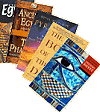|
|
||||||||||
|
|
The birth of administration
However, all this came at a price. Pharaoh, as sole owner of all the land in the country, was able to commandeer food (in the form of taxes), people and resources at his pleasure. As a means of preventing internal unrest, Pharaoh embarked on vast building projects. Many of these would divert a large number of the populous away from their normal activities during the inundation period, when the agricultural farmland was covered by floodwater. These projects took the form of a type of "National Service", known as a corvee, during which the workforce would be provided with accommodation, food and clothing. Considered exhausting work, and not necessarily overly popular with the workforce involved, a scribes record records:
The result of the corvee was to apply tremendous pressure on the remainder of the population to produce the country's necessary products. Farming methods and taxation became strictly controlled and maintained by the scribes (who were exempt from paying taxes and project work), recording in minute detail the output from each farm. A certain Amunt of this output was then sent to Pharaoh in the form of a tax. To maintain his authority, Pharaoh would constantly move between towns. As the High Priest of every temple in the land he was expected to perform their sacred rites, honouring the local deities. Moreover, his moving between towns served a more important role. Pharaoh was able to operate a visual authority over his people, here was their demi-god in person, not some remote mystical figure hidden away in some obscure palace or temple. He was able to maintain contact with the provinces ensuring that the local governors were maintaining his laws justly, a physical reminder of the ultimate authority in the land. Visiting the various towns was also an ideal opportunity for Pharaoh to prevent the local governors from becoming too powerful. Pharaoh would send expeditions and raiding parties into neighbouring countries in an effort to expand Egypt’s borders. These raiding parties utilised the local population, therefore ensuring that the governors were never able to challenge his authority by raising their own standing armies. Religion and tomb development >>
|
|||||||||

|
||||||||||
|
||||||||||






 The Egyptians believed that writing had been invented by the god Thoth, who was usually pictured as a scribe with the head of an ibis. They believed that words, whether they were written or spoken, had a magical power. Thus the scribe played a special role in the kingdom. The population during the Old Kingdom consisted of approximately one million people, of whom less than one percent were literate. They therefore held the scribe in high esteem, obeying and trusting his orders.
The Egyptians believed that writing had been invented by the god Thoth, who was usually pictured as a scribe with the head of an ibis. They believed that words, whether they were written or spoken, had a magical power. Thus the scribe played a special role in the kingdom. The population during the Old Kingdom consisted of approximately one million people, of whom less than one percent were literate. They therefore held the scribe in high esteem, obeying and trusting his orders.